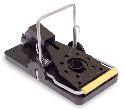My workspace at work occupies the lobby of our business, and I am virtually alone all day, except for the vendors and co-workers who traverse my area periodically. Thus, I often whistle or hum to myself while I work, knowing that my "music" won't bother anyone. Last week I was whistling tunes from old TV sitcoms and Sara came to speak with me just as I was finishing whistling a stanza of the "The Brady Bunch" theme song. She just glared at me and said, "Thanks for the earwig."
Sara was talking about a tune that gets stuck in your head that you can't seem to shake, and not the insect by the same name. An earwig is menacing-looking insect, with large forcep-like pincers on its end. And, contrary to myth, earwigs do not burrow into your ear canal to lay eggs that will eventually hatch with resulting earwigs feeding from your brain. Perhaps the myth perpetuated from the fact that earwigs are slender, like to hide in moist places, and could actually fit into a moist ear canal. Yet, that is simply a myth.
Here are some actual facts about earwigs:
The female earwig creates a burrow about three inches below the soil in which to lay her eggs, and can lay up to 60 eggs at a time. Earwigs over-winter in the soil and then hatch, living only one generation.

The End of the Road for Mice! Quickly eliminate pesky mice and small rodents with this handy six-pack of traps. Easy to bait, set, use, and release. Unique design catches rodents from the front, sides, and back. Simple, safe, sanitary, and reusable for years. Check out Snap-E Mouse Traps today!
Getting rid of termites is so important that if termites show up in a home inspection, it can potentially threaten the ...
Discover MoreSilverfish are small nocturnal insects that thrive in humid environments. They thrive on eating sugars and starches found ...
Discover MoreTermites look like little white ants. Don't be fooled, they can cause enough damage to make a house unlivable.
Discover MoreThere are currently no comments for this tip. (Be the first to leave your comment—just use the simple form above!)
Copyright © 2025 Sharon Parq Associates, Inc.
Comments